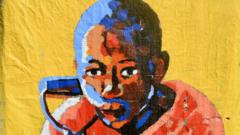Zambia is home to the famous "black mountains," mounds of mining waste that loom ominously over the Copperbelt landscape. This visual scar deeply resonates with artist Stary Mwaba, who grew up in the area. "We knew it was 'mu danger' - a place to avoid," he recalls from his childhood, where he and his friends would sneak in to forage wild fruits seemingly thriving on the toxic dumps.
Today, young men flock to these hazardous sites, scavenging for copper ore among the remnants of a century's industrial mining in a nation striving to emerge as one of the leading copper and cobalt producers globally. They create intricate tunnels to extract rock, sometimes selling it to Chinese firms who further process it. These underground activities are fraught with peril, often surviving on the fringe of legality—yet, with youth unemployment in the region hovering around 45%, for many, this risky endeavor is their only means of survival.
Currently, Mwaba's exhibition at the Lusaka National Museum highlights the plight of miners in Kitwe, showcasing their lives in the neighborhood of Wusakile. He captures the essence of this experience with a series of evocative portraits, meticulously crafted on old newspaper canvases. Employing a distinct technique, Mwaba layers his art with resonating "grand narratives" from newspapers, burning away parts of the text to create "little narratives" from the stories of ordinary people, blending them into his depictions.
His portraits, vibrant yet fragile, mirror the lives they represent—individuals struggling yet resilient. One notable piece, "Jerabo," portrays a young miner preparing for a hazardous descent into narrow tunnels, reflecting the intense risks these individuals undertake. Mwaba's workshop interactions yield powerful feedback, with individuals sharing stories punctuated by hardship, revealing their daily realities.
Amid an ongoing environmental crisis, earlier this year saw Kitwe experience a water shut-off after a spill from a Chinese mine tainted local waterways, exacerbating the community's challenges. Mwaba captures these societal issues in his work, portraying tools like the shovels miners rely on symbolically as “personal lifelines.”
Many of the narratives captured are about community and resilience. Mwaba depicts social lives where church gatherings and bars frequently serve as sanctuaries from harsh realities. His art goes beyond mere representation; it fosters dialogue about the acute social and economic strains that young miners experience.
Despite facing the generational legacies of mining, such as job losses stemming from privatization in the 90s, Mwaba's works offer glimmers of hope, encouraging conversations about the future and the choices available to today's youth. One painting, "Boss for a Day," contemplates the aspirations of a young miner posing proudly, reflecting the lost dreams of many who feel trapped within an exploitative cycle.
Mwaba's mission extends to changing perspectives—he recalls a moment when an elder miner, touched by his work, expressed a desire for future generations not to follow the same path of hardship. Such transformative moments underscore the significant healing potential of Mwaba’s art amid societal disruption.
Through his latest body of work, Stary Mwaba not only exposes the harsh realities of Zambia's mining legacy but also champions the voices of those living in its shadow, bringing hope and a platform for dialogue to the forefront.



















